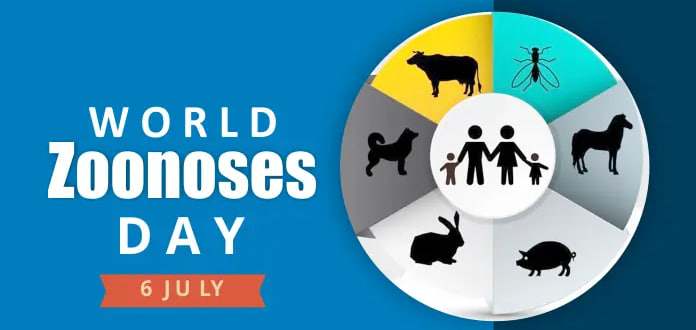
Copyright infringement not intended
Context: Zoonotic diseases are infections that can be transmitted from animals to humans, such as rabies, anthrax, and COVID-19. They pose a serious threat to public health and biodiversity. To raise awareness and promote the prevention of these diseases, World Zoonoses Day is celebrated every year on July 6th.
Details
- The Day marks the anniversary of the first successful vaccination against rabies by Louis Pasteur, a French biologist who made groundbreaking discoveries in microbiology and immunology.
- The theme for World Zoonoses Day 2023 is “One World, One Health: Prevent Zoonoses, Stop the Spread”. The theme reflects the need for a holistic and collaborative approach to address the complex interactions between humans, animals, and the environment that influence the emergence and spread of zoonotic diseases.
World Zoonosis Day aims to promote collaboration and coordination among different sectors and stakeholders to prevent and control zoonotic diseases. It also encourages people to adopt healthy behaviours and practices to reduce the risk of exposure to zoonotic pathogens.
Some of the recommended actions by World Health Organisations are:
- Wash your hands frequently with soap and water or use alcohol-based hand rubs.
- Avoid contact with sick or dead animals or their products.
- Cook animal products thoroughly before eating them.
- Seek medical attention if you have symptoms of a zoonotic disease or if you have been bitten or scratched by an animal.
- Vaccinate your pets and livestock against zoonotic diseases and keep them away from wildlife.
- Report any suspected cases of zoonotic diseases to the local health authorities.
- Support efforts to conserve wildlife habitats and biodiversity.

Zoonotic diseases
About
- Zoonoses are caused by bacteria, viruses, parasites, fungi, or prions that infect animals and can also infect humans through direct contact, food, water, or environmental exposure. Some examples of zoonotic diseases are rabies, anthrax, salmonellosis, leptospirosis, Lyme disease, and COVID-19.
- Zoonotic diseases pose a serious threat to public health, animal health, and biodiversity. They can cause outbreaks, epidemics, and pandemics that affect millions of people and animals around the world.
- According to the World Health Organization (WHO), zoonoses account for about 60% of known infectious diseases in humans and 75% of new or emerging ones.
Factors Contribute to the Emergence and Spread of zoonotic diseases
- The emergence and spread of zoonoses are influenced by factors such as human population growth, urbanization, deforestation, climate change, wildlife trade, and agricultural intensification.
Increased human population and encroachment into wildlife habitats
- As the human population grows, more people live in close contact with wild animals, increasing the risk of exposure to zoonotic pathogens. Human activities such as deforestation, mining, agriculture, and urbanization also reduce natural barriers between wildlife and humans, creating opportunities for spillover events.
Intensification and expansion of livestock production
- The demand for animal products such as meat, eggs, and milk has led to the intensification and expansion of livestock production systems, often with poor biosecurity and animal welfare standards. This creates favourable conditions for the emergence and transmission of zoonotic diseases among animals and from animals to humans.
Globalization and increased movement of people, animals, and goods
- The rapid and frequent movement of people, animals, and goods across borders and regions facilitates the spread of zoonotic diseases around the world. Travellers, migrants, traders, smugglers, and tourists can carry zoonotic pathogens with them, introducing them to new areas or re-introducing them to areas where they have been eliminated or controlled.
Climate change and environmental degradation
- Climate change and environmental degradation affect the distribution and abundance of wildlife hosts and vectors of zoonotic diseases, as well as their interactions with humans and domestic animals. Changes in temperature, precipitation, humidity, and vegetation can alter the ecology and behaviour of wildlife species, increasing or decreasing their susceptibility to infection or their ability to transmit zoonotic pathogens.
Inadequate surveillance and response systems
- Many countries lack adequate surveillance and response systems for detecting and controlling zoonotic diseases. This hampers the timely identification of outbreaks, the implementation of effective prevention and control measures, and the sharing of information and resources among stakeholders.
- Weak surveillance and response systems also increase the risk of underreporting or misreporting zoonotic disease cases, leading to inaccurate estimates of their burden and impact.
Challenges that need to be addressed
Lack of awareness and coordination
- Lack of awareness and coordination among different sectors and stakeholders. Zoonotic diseases often involve multiple disciplines, such as human health, animal health, the environment, agriculture, and trade. However, there is often a gap in communication and collaboration among these sectors, leading to missed opportunities for early detection and response.
Inadequate resources and capacities
- Insufficient resources and capacities for detection, diagnosis, and treatment. Many countries lack the necessary infrastructure, equipment, personnel, and funding to effectively monitor and manage zoonotic diseases. This hampers the ability to identify outbreaks, confirm the causative agents, and provide timely and appropriate care to affected populations.
Weak legal and regulatory frameworks
- Weak legal and regulatory frameworks for animal health and welfare. Zoonotic diseases can originate from various sources of animal contact, such as wildlife trade, livestock production, pet ownership, and hunting. However, many countries do not have adequate laws and regulations to ensure the health and welfare of animals, as well as to prevent the illegal or unsafe trade and consumption of animal products.
Socio-cultural and behavioural barriers
- Socio-cultural and behavioural barriers to adopting preventive measures. Zoonotic diseases are influenced by human behaviours and practices that affect the exposure to and transmission of pathogens. These include cultural norms, beliefs, preferences, habits, and traditions that may increase the risk of zoonosis. For example, some communities may have a preference for consuming raw or undercooked meat or animal organs or may have a strong attachment to keeping certain animals as pets or companions.
Limited access to safe and nutritious food
- Zoonotic diseases can also result from food insecurity and malnutrition, which can compromise the immune system and increase susceptibility to infections. Moreover, foodborne zoonoses can cause serious illness and death among consumers who ingest contaminated food products. Therefore, ensuring access to safe and nutritious food is essential for preventing and reducing the burden of zoonotic diseases.
Steps Taken by the Government
- Establishing a national zoonoses committee and a national zoonoses unit under the Ministry of Health and Family Welfare to coordinate and monitor the surveillance, prevention and control of zoonotic diseases.
- Strengthening the laboratory network and diagnostic capacity for zoonotic diseases at the central, state and district levels.
- Developing guidelines, protocols and standard operating procedures for the management of zoonotic diseases and outbreaks.
- Regular training and capacity-building programmes for health workers, veterinarians, animal handlers and community members on zoonotic diseases and their prevention.
- Implementing mass vaccination campaigns for animals and humans against rabies, Japanese encephalitis, brucellosis and other zoonotic diseases.
- Promoting inter-sectoral collaboration and coordination among various ministries, departments, agencies and stakeholders involved in zoonotic disease control.
- Participating in global initiatives and partnerships such as the One Health approach, the Global Health Security Agenda, the International Health Regulations and the World Organisation for Animal Health (OIE) to enhance preparedness and response to zoonotic diseases.
- Conducting research and surveillance on emerging and re-emerging zoonotic diseases and their risk factors.
- Raising awareness and educating the public about the transmission, symptoms, treatment and prevention of zoonotic diseases through various media platforms.
Ways forward to tackle zoonotic diseases
- Strengthening surveillance and early warning systems at the local, national, regional, and global levels to detect and respond to potential outbreaks of zoonotic diseases in a timely manner.
- Enhancing research and innovation to develop new diagnostic tools, vaccines, therapeutics, and prevention strategies for zoonotic diseases, as well as to understand their drivers, dynamics, and impacts.
- Improving communication and education to raise awareness among the public, policymakers, and stakeholders about the risks and benefits of human-animal interactions, and to foster behaviour change that reduces exposure to zoonotic pathogens.
- Supporting livelihoods and food systems that are resilient and sustainable, and that minimize the negative impacts of human activities on wildlife habitats, biodiversity, and ecosystem services.

Conclusion
- Zoonotic diseases are infections that can be transmitted from animals to humans. They pose a significant threat to public health, animal welfare, and biodiversity. To prevent and control zoonotic diseases, a One Health approach is needed, which integrates human, animal, and environmental health. This approach requires collaboration and coordination among multiple sectors and disciplines, as well as awareness and education among the general public. By working together, we can reduce the risk of zoonotic diseases and protect the health of people, animals, and the planet.
Must-Read Articles:
Livestock and Zoonosis: https://www.iasgyan.in/daily-current-affairs/livestock-and-zoonosis
ZOONOSIS THEORY: https://www.iasgyan.in/daily-current-affairs/zoonosis-theory
‘ONE HEALTH’ APPROACH: https://www.iasgyan.in/daily-current-affairs/one-health-approach-37
|
PRACTICE QUESTION
Q. Which of the following is a zoonotic disease that can be transmitted from livestock to humans?
1. Rabies
2. Anthrax
3. Brucellosis
4. Ringworm
How many of the above statements is/are correct?
A) Only 1
B) Only 2
C) Only 3
D) All
Answer: D
Explanation: Zoonotic diseases are diseases that can be passed from animals to humans. Rabies, anthrax, Ringworm and brucellosis are examples of zoonotic diseases that can affect both livestock and humans.
|
https://pib.gov.in/PressReleasePage.aspx?PRID=1937850




